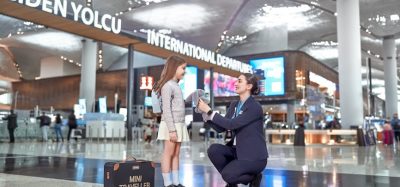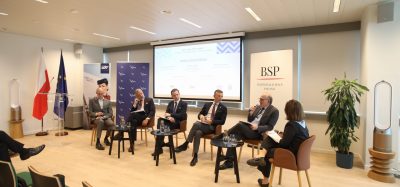“Going to the North Hub Riga”
- Like
- Digg
- Del
- Tumblr
- VKontakte
- Buffer
- Love This
- Odnoklassniki
- Meneame
- Blogger
- Amazon
- Yahoo Mail
- Gmail
- AOL
- Newsvine
- HackerNews
- Evernote
- MySpace
- Mail.ru
- Viadeo
- Line
- Comments
- Yummly
- SMS
- Viber
- Telegram
- Subscribe
- Skype
- Facebook Messenger
- Kakao
- LiveJournal
- Yammer
- Edgar
- Fintel
- Mix
- Instapaper
- Copy Link
Posted: 26 May 2009 | Richard Piper, Commissioning Editor | No comments yet
The aim of the conference was to discuss current global trends in the aviation industry, with a specific focus on the Baltic region. This would also include discussions and presentations looking at the development of RIX, on its way to becoming an important air traffic hub.
It was in good spirits that I found myself in the executive lounge at Gatwick airport’s South Terminal. airBaltic had very kindly booked me a seat on their business class service and I must confess to having made the most of it!
A short time later, flight BT 652 was whisking myself, and a handful of other journalists, to Riga International Airport in Latvia. From there we were met by a representative from the airline and taken to the Radisson SAS Daugava hotel, where “Going to the North Hub Riga” would be held.
The aim of the conference was to discuss current global trends in the aviation industry, with a specific focus on the Baltic region. This would also include discussions and presentations looking at the development of RIX, on its way to becoming an important air traffic hub.
Mr Bertolt Flick, President and CEO of airBaltic, gave the welcoming address, commenting on the rapid development at Riga International Airport, describing it as a “rollercoaster ride.” In the past, airBaltic had hosted several smaller gatherings of industry partners and it was testament to how far the region has progressed that so many senior aviation officials had gathered in Riga on the day.
Mr Flick was followed by Mr Kaspars Gerhards, Minister of Transport and Communications for the Republic of Latvia, who delivered the opening address. It was the opinion of Mr Gerhards that Government policy relating to aviation should be transparent, comprehensible and in compliance with the current economic situation.
The first presentation was given by Mr Ragnar Nordvik, Regional Director of Marketing at Boeing, who looked at global trends in the aviation industry and the market growth rates forecasted for the next 20 years. It was suggested that European airlines alone would need an additional 6,900 aircraft to cope with traffic increases up to the year 2027. The conclusion was that the long term market is strong, with a world average growth rate of 5.0% per annum for air travel.
The next key contribution was from Roberts Zile of the European Parliament Committee on Transport and Tourism. Mr Zile gave us an insight into the legislative challenges for European air traffic, covering everything from the controversial issue of airport charges to greenhouse gas emissions.
In the final presentation of the first session, Dr. Johannes Baur from DG-TREN, European Commission, gave a presentation entitled “The EU and Eastern Europe – progress towards a Common Aviation Area.” Dr. Baur covered what are known as “The Three Pillars of the External aviation policy of the EU” namely; Bringing existing bilateral agreements into line with Community law; Conclusion of ambitious global agreements with key partners; The creation of a “Common Aviation Area” with neighbouring countries.
There then followed a press conference with Bertolt Flick of airBaltic and Dr. Mustafa Sani Sener of TAV. Questions were centred around the proposed new Terminal 2 at Riga International Airport. Bertolt Flick explained that Riga is rapidly becoming a transfer hub which is shaping aviation in the Baltic region, and there is a great need for a new terminal as there are severe restrictions at the current facility.
airBaltic carry 50% of the passengers through Riga Airport and therefore would be the main beneficiary of a new terminal facility.
Following a tender process, TAV are listed as the preferred supplier for the development of this facility. They are planning a phased investment of between 250 and 300 million Euros and hope to have finished contract negotiations by 7th July ’09.
Mr Flick said that TAV and airBaltic have started to discuss how to move forward with the terminal if RIX is not in a position to do so.
The second session after the coffee break consisted of presentations from various airlines, looking at their respective figures, destinations and habits. Among those presenting were SAS, Aeroflot and Lufthansa. Each gave a very interesting insight into the challenges they are facing at present and the measures being taken in order to cope with the economic downturn.
Bertolt Flick followed on from this with his presentation from airBaltic. The airline has experienced massive growth in recent years and Mr Flick talked us through the various developments within the Baltic marketplace. airBaltic have a strong focus on developing the transfer model, as Riga is considered to be very favourably placed on the Northern and Eastern edge of Europe. It is therefore very important to increase capacity at Riga Airport in order to accommodate this growth in transfer traffic.
Krišja-nis Peters, Chairman of the Board, SJSC Riga International Airport, then delivered his presentation, looking at how RIX intends to become an airport city going forward.
A master-plan is being put together, and will be completed in June of this year. It is clear that infrastructure development is needed to sustain the current growth rates.
To talk about airport construction and operation, Dr. Mustafa Sani Sener, President & CEO of TAV Airports Holding, came to the podium. His presentation was entitled “Beyond the experience is know-how.” Dr. Sener described airports as “the melting pots of globalisation” and spoke at length on PPP projects in the aviation industry. In line with the general consensus, Dr. Sener agreed that a new terminal was vital at RIX, stressing that expansion is important if capacity is to keep up with demand.
We then moved on to the next section, “Airports – a global mirror of social trends and customers expectations.”
The first presentation was given by Mr. Marjan Schoeke of Berlin Brandenburg International Airport. Mr. Schoeke described BBI Airport as “Berlin’s future” and said that it is essential for sustained passenger growth. The airport will have an initial capacity of 22-25 million passengers.
This was followed by Mr Alexander Schroll, Director of Traffic Development at Munich Airport, who walked us through “The dynamic development and visions of Munich Airport.” He touched on MUCs present market situation and strategy, Munich’s development to an Airport City and their overall expansion concept.
A panel discussion rounded off the proceedings, which allowed attendees to ask questions of a panel of airline and airport representatives. The subject header was “Airlines – airports, customers expectations and cost efficiency.”
The closing remarks were delivered by Mr Bertolt Flick, at around 17.00pm, who thanked everyone who had attended and concluded what was an informative and thought provoking day.
It appears that, despite the politics and speculation surrounding the new terminal project, there is clearly a need for this to move forward and move forward rapidly. With the phenomenal growth experienced in the region over the past years, and the expected continuation of this growth, capacity will have to be expanded to accommodate the many people choosing to fly to the “North Hub Riga.”
Finally, I would like to take this opportunity to thank Janis Vanags, Dace Feldmane, Liene Dupate and Iveta Bieza of airBaltic. The organisation and hospitality they demonstrated was unsurpassable.

















